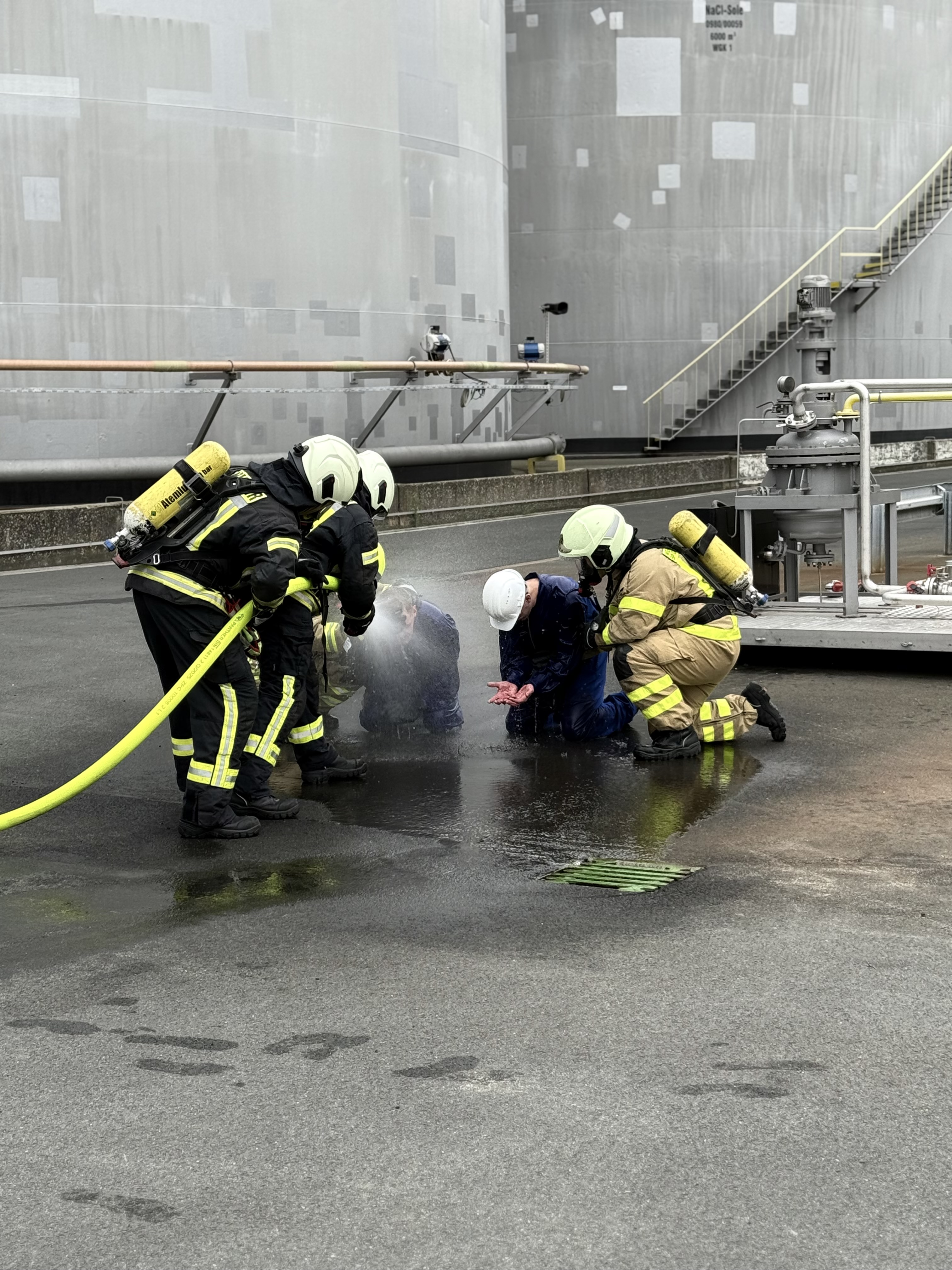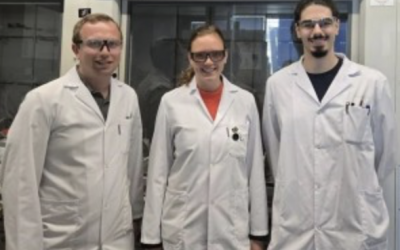Prevent accidents and respond correctly in critical situations. Gain insights into state-of-the-art safety concepts that companies can use to prepare and protect themselves effectively. Immerse yourself in exciting live demonstrations. The German Plant Fire Brigade Association (WFVD) will be showcasing the latest developments and innovative measures in a huge action area.
After all, systematic and well-organised fire safety regulations can save lives and minimise damage to buildings and equipment. Companies must therefore take appropriate precautions and regularly check that their fire safety measures are up to date. In addition to fire prevention, effective emergency management is also of great importance in order to be able to act quickly and efficiently in the event of an emergency.
How do accidents typically occur?
How do you react when corrosive liquid leaks from a container? The consequences are often serious. Trainees from the Rain Carbon plant fire brigade in Castrop-Rauxel, BP in Gelsenkirchen, Evonik Witten and Wesseling, Axalta Wuppertal and Ineos Phenol in Gladbeck demonstrate how to respond in an emergency and how to care for those affected. They practise well in advance for the WFVD action area. They also shoot a film for the trade fair – all in their company’s own equipment, by the way – which illustrates how such accidents typically occur.
Another highlight is an airfield fire engine, which is used to ensure fire safety on airfield operations areas. In the simulator, visitors can practise how to move the huge vehicle and how, for example, water cannons are automatically extended.
Acting correctly in an emergency
Acting correctly in an emergency: Exercises with a first-aid dummy are also carried out using a simulator. It has the same airway resistance as a real person and can only be ventilated if the head is correctly extended. During chest compressions, it has realistic thoracic compression and reports whether the measures taken were successful.
Various companies present their highlight products. Dräger provides insights into the latest measurement technology for drones. ForLife, as a fitness trainer, demonstrates its individual tests and programmes for fire brigades and rescue services. After all, fitness and mental health are the basis for remaining productive in this challenging profession. The company Northdocks invites visitors to attend hazard prevention training in virtual worlds. This is a mobile training solution that gives fire brigades and organisations the opportunity to train realistic scenarios with fire extinguishers and jet pipes in virtual reality – quickly, safely and regardless of location. The system is supplemented by modules such as CPR training, first aid and simulation games.
The future of smart PPE
The latest developments in clothing technology will be presented and an outlook on the future of smart PPE will be provided. In collaboration with Smart PSA GmbH, cubos Internet GmbH will demonstrate intelligent indoor positioning with emergency buttons for alerting in dangerous situations. The buttons can also be connected to other IoT devices.
Another important topic in the action area is decontamination after deployment. This is organised by colleagues from the Feuerkrebs organisation. This year, there will be practical demonstrations showing how a firefighter – assisted by a hygiene assistant – safely removes his contaminated protective clothing without contaminating himself or running the risk of absorbing carcinogenic substances.
Live demonstrations will take place daily from 10 a.m. to 4 p.m.:
Visitors can experience first-hand how effective fire protection measures work in practice and gain inspiration for their own safety precautions. Interested parties are also invited to the WFVD stand party on Thursday, 6 November.
Hands-on fire protection: practice, innovation, inspiration
The communications professionals at A+A spoke with Christian Ronig from the Evonik plant fire brigade in Marl and the deputy chairman of the WFVD about current trends, opportunities and challenges.
A+A: Are drones being used more and more frequently in firefighting? What is already working well?
Christian Ronig: “We already work a lot with drones. The images can be transferred to any device. Visually, the drones are great.
There are two systems. One can be flown from the operations centre. For example, I can sit in the Marl Chemical Park and view a remote location. Our drones can also be equipped with Dräger measurement technology, so that we not only receive images, but also values for the concentration of hazardous substances in the environment in the event of leaks. The data is transferred to various devices such as tablets.
The second system (tethered drones) is used by Currenta, for example, from their emergency vehicles. The drones are tethered to cables. We will be demonstrating both at the trade fair.
There are also fixed-wing drones that can fly much further, but cannot hover. They have to be flown in circles and are therefore not suitable for factory fire brigades.
Operations with free-flying drones are not so easy to plan. You need a permit from the Federal Aviation Authority (LBA), a risk assessment must be carried out in advance and everything must be documented. That is quite time-consuming. Tethered drones are less complicated.”
A+A: And what else could be improved?
Christian Ronig: ‘The sensor technology is limited by the performance of the drone. It quickly becomes too heavy, too large and therefore too expensive. It would also be desirable to significantly improve the battery life of 30-35 minutes.’
A+A: Are there also acoustic signals such as announcements or warnings via drones?
Christian Ronig: ‘That is theoretically conceivable and certainly makes sense, but we as a plant fire brigade do not yet use it. As a rule, the plants also have their own systems for announcements.’
A+A: What about the use of smart clothing that monitors the vital parameters of emergency personnel, for example?
Christian Ronig: ‘Initial trials with such clothing are already underway. And that certainly makes sense, because there are fewer colleagues with many years of experience, and there is a higher turnover than in the past. Young people are very receptive to new techniques and technologies. That’s why we have to try to collect more data and then make it available.’
A+A: What about digitalisation, AI, virtual and augmented reality in training?
Christian Ronig: “AR and VR are being used more and more frequently. In our action area, we are showing simulated driver training for an airport emergency vehicle. This can easily be transferred to other types of vehicles. Hazardous operations such as extinguishing fires with fire extinguishers and jet pipes can also be simulated using VR glasses.
Software solutions are particularly useful for staff training because data from different sources can be linked and then used or applied.
Furthermore, it is not easy to work digitally or with AI support because the security requirements for data protection are very high for the fire service. We cannot use open source models. AI-supported work is therefore not yet part of our everyday reality.”
A+A: How are you adapting your operational strategies to climate change and extreme weather events?
Christian Ronig: “In addition to the outside temperature, the heat in the factory fire brigade comes from the waste heat of the machines and systems. Among other things, we have purchased climate vests for better protection. Vegetation fires require completely different equipment. And as long as the emergency services don’t have that, the only thing that helps is drinking plenty of fluids and faster relief during the often very long firefighting operations.
But the three days at the end of June with temperatures of up to 40 degrees were also a challenge for us in Marl. It is important to do a lot in advance to ensure that you are well prepared in extreme cases. We work with heavy rain maps, which are available free of charge on the internet. If you are well prepared, you can then direct the water so that nothing gets blocked. We have also retrofitted flood modules (submersible pumps and generators) so that we can work and pump independently. Climate hazards such as heavy rain, flooding and fires were also the topic of our annual event in Berlin in January.”
A+A: How do you attract and retain qualified emergency personnel?
Can technological tools compensate for some personnel shortages?
Christian Ronig: “The shortage of skilled workers is also a major problem for us. The baby boomers are retiring, there are few interested successors, and young people often lack the necessary fitness. In addition, the public sector is a strong competitor for us. All fire brigade trainees still do their training together, but then we lose people. The public sector attracts them with job security and good pay.
The advantage of plant fire brigades is that we can score points with special technology and larger vehicles. In addition, there are no attacks on emergency personnel and the many trips made by the rescue service are also eliminated. Our focus is on prevention, so that we don’t have to respond to incidents in the first place. In our image film, which can be seen at the trade fair, individual plant fire brigade members talk about their work. We hope to appeal to a wide range of interested parties.
Improved safety technology has led to a decrease in fires and environmental incidents in recent years, but new risks are constantly emerging. New materials in the construction sector (e.g. façade insulation), increased installation of building technology and, last but not least, the use of lithium-ion batteries in all areas of daily life. Entire fire stations have even burned down because the batteries in the equipment on the vehicles caught fire. But here, too, developments are continuing. It remains important to always be prepared for new dangers.
Firefighting is and remains a personnel-intensive job and therefore continues to be an exciting job with a future!”



